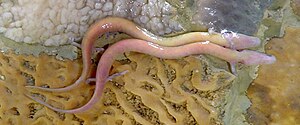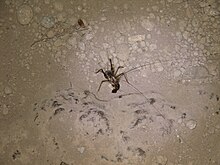Cave animal
A cave animal is an animal that occurs more or less frequently in caves .
In the sense of a habitat , caves mean natural or anthropogenic rock caves, but also smaller structures such as holes, cracks and tree hollows in dead wood, also artificial cavities, springs or submarine cavities. The size at which a cavity is called a cave depends on the size of the animal and the researcher's judgment. In contrast to this and with reference to humans, speleology (cave science, from the Latin spelaeum "cave" and logic ) only describes naturally created cavities with a length of more than five meters as caves.
Fauna groups are differentiated depending on the degree of adaptation and the frequency of stay in the cave.
In cultural and mystical terms, caves are associated with images of primeval monsters, such as dragons .
Classic cave faunas classification
Troglox fauna
Animals that are actually not cave dwellers (epigeic fauna) and only get into caves by chance (unintentionally) are called trogloxes (from Greek trogle "cave, hole" and Greek xeno "foreign", ie "cave alien"). They are not adapted to this habitat. These are random guests, e.g. B. Ground dwellers who either accidentally get into caves or have visited them in search of food or fleeing drought or precipitation.
Troglophilic fauna
Animals are called troglophil (from the Greek trogle "cave, hole" and Greek φίλος phílos "friend, loving, devoted", so "cave friends") if they prefer caves as a complementary habitat (habitat) with some regularity or if they are dependent on them at times are. They have adaptations that enable them to orientate themselves in the twilight of the entrance area or in deeper regions. Certain functions such as breeding or retreat require visiting a cave.
Troglobionte fauna
Troglobiont (from Greek trogle "cave, hole" and Greek βίος bíos "life" and Greek on , Gen. ontos "being") are real cave dwellers if they live exclusively in caves and are dependent on caves in all stages of development Leaving caves only by accident. These animals are usually very sensitive to changes in temperature.

Often these animals are largely colorless and the eyes are rudimentary withered. The loss of sight is often offset by an enhancement of other senses, such as touch.
Cave Fauna Detailing
The classic three-part classification proved to be too rough for zoologists as early as the 19th century to be able to assign each species found in caves to exactly one group according to scientific criteria. In order to do justice to those animals that did not exactly fit into one of the three classification groups, further subdivisions were made.
Troglophil could be further downgraded into:
- Subtroglophilic fauna: subtroglophilic animals only spend parts of their lives in caves.
- Eutroglophilic fauna: eutroglophilic animals mainly live in caves.
Accordingly, further more or less meaningful subdivisions and new terms were created and published, but not applied consistently. Misunderstandings and allocation problems developed from the different naming systems.
Current cave fauna classification
Numerous classifications have been presented and discussed since the end of the 19th century. This did not result in a uniform and binding structure for cave animals, but a form of structure by Albert Vandel largely prevailed. This classification endeavors to include as many of the classification suggestions and terms that have already been used as possible, but some classification suggestions are not taken into account:
- Trogloxen fauna (in the classical sense): Epigeic fauna, trogloxen animals are not cave dwellers, they only get into caves by chance. This classification is only chosen, however, if a distinction between eutrogloxes and subtroglophiles is not possible.
- Eutrogloxed fauna: eutrogloxed animals only get into caves by chance, they are also trogloxed.
- Subtroglophilic fauna: subtroglophilic animals only spend parts of their lives in caves. A large part of the population specifically seeks out caves, but only spends short periods of life there (overnight stays, wintering, hiding, in the larval stage or other periods of life). Although the content is actually better suited to the eutroglophiles, subtroglophiles are left as a subgroup of the trogloxes in order to be able to continue to interpret earlier publications.
- Eutroglophilic fauna (was "troglophile" in the classic sense): eutroglophilic animals mostly live in caves for generations, but can occupy other suitable (moist) biotopes outside the cave at any time.
- Eutroglobiont fauna (was “troglobiont” in the classical sense): eutroglobiont animals spend all stages of their life in caves, they are dependent on this biotope and cannot live in other habitats for long periods of time.
Cave aquatic animals
Many cave aquatic animals also occur outside of caves in the groundwater. The group of living things found in the groundwater is known as Stygobionta .
According to the cave fauna in general, the animals in the groundwater (including underground waters and springs) can also be classified:
- Stygoxen fauna: accidentally in underground waters
- Stygophilic fauna: occurs voluntarily and at times preferentially in underground waters
- Stygobionte fauna: must live in underground waters, real groundwater animals
Examples
Eutrogloxene
The name of the cave goat ( Myotragus balearicus ) was formed as an analogy to other animals of the Pleistocene (for example the cave bear , the cave lion and the cave hyena ), although there is no evidence that it was in caves.
Subtroglophiles
The Pleistocene animals that only visited caves from time to time, but whose skeletal parts survived there better and were named after them: cave bears, cave lions, cave hyenas, who used caves as shelter. However, these animals only lived in the spacious entrance area and looked for food outside the cave.
Bats , various toads , newts, salamanders , rodents (mice, dormice), bears, woodlice, harvestmen, beetles, snails and many other animals use caves regularly or occasionally as a shelter and temporarily move into stone caves, tree caves, in cavities under stones, back under the bark, especially in cold seasons with little food.
The cave-nesting bird fat schwalm ( Steatornis caripensis ) has an echo sounder system that is similar to that of bats. The click signals generated in this way have a low frequency (1.5–2.5 kHz ), but in contrast to the ultrasonic tones of bats, they are audible to humans. In the group, fat swallows produce a deafening noise level, so that the fat swallow is the loudest of all birds. This natural sonar enables the animal to find its way in the darkness of the Andean caves as if it were searching for food outside the cave at night for oil-containing fruits. This diet causes him to accumulate a lot of body fat , which serves as a heat reservoir in the cave and has given him his name.
The only “cave snake ” is the fine snake Orthriophis tennurius, Syn. Elaphe taeniura , a tree snake that preyes on bats in Malaysian caves.
Eutroglophiles
Some species of barn flies (Heleomyzidae) have been identified as eutroglophilic, some other species as subtroglophilic.
Eutroglophilic centipedes have been identified in caves in Luxembourg.
Many arthropods such as cave-dwelling centipedes , cave isopods , cave crickets or cave beetles have enlarged antennae.
Eutroglobionte
The best known eutroglobionte (troglobionte) animal, which was first scientifically described in 1768, is the cave olm ( Proteus anguinus ), a relative of the newt. He spends his entire life in the underground waters of the Eastern European karst caves . When hatching, the cave olms still show different characteristics of their "free living" relatives. They have well-developed eyes and are equipped with black color cells on their backs. The reproduction of the animals takes place during this larval phase. Then the pigmentation disappears completely, the eyes and also the optic nerves atrophy. After about 18 months the olm will be completely white and blind.
For various cave fish such as the North American blind cave fish Typhichthys spec. an increased sensitivity to currents was found. He avoids the daylight zone.
Other eutroglobiont species:
- Texan well newt
- Astyanax jordani , a blind cave tetra
- Blind fish
- Cave shrimp
- Dwarf horn snails of the genus Zospeum
See also
literature
- W. Weißmmair, E. Hauser: Fauna of the Rettenbach cave (Biospeläologie; Upper Austria). (PDF; 622 kB) In: Linzer biol. Contribution Volume 25, No. 1, 1993, pp. 373-385. (Contains a list of the specific animals according to the current classification)
- Project group "Subterranean Fauna"
Single receipts
- ↑ a b c d e f g h i j k l m n o p q r Klaus Dobat, Stefan Zaenker: Leaflet on Biospeläologie. ( Memento of March 4, 2016 in the Internet Archive ) accessed September 8, 2013.
- ↑ a b c d e Curt Koßwig: considerations and experiments on the development of cave animal features. In: Theoretical and Applied Genetics. Volume 9, No. 4, 1937, pp. 91-101.
- ^ JH Carpenter: Behavior and ecology of Speleonectes epilimnius (Remipedia: Speleonectidae) from surface water of an anchialine cave on San Salvador Island, Bahamas. ( Page no longer available , search in web archives ) Info: The link was automatically marked as defective. Please check the link according to the instructions and then remove this notice. In: Crustaceana. Volume 72, 1999, pp. 979-991.
- ↑ Albert Vandel: Biospeleology: the biology of cavernicolous animals. Pergamon Press, Volume 22, 1965, ISBN 0-08-010242-5 .
- ↑ Richard Burleigh, Juliet Clutton-Brock : The survival of Myotragus balearicus bate, 1909, into the neolithic on mallorca. In: Journal of Archaeological Science. Volume 7, No. 4, 1980, pp. 385-388. Quote: "This strange animal has no common name; it is called the" cave goat "by Kurtrn (1968) but it is unlikely that it spent very much of its waking life in caves".
- ^ Steatornis caripensis. (Oilbird). on: eol.org
- ↑ National Geographic
- ↑ Liz Price: An introduction to some cave fauna of Malaysia and Thailand. (PDF; 574 kB) In: Acta Carsologica. Volume 33, No. 1, 2004, pp. 311-317, p. 314.
- ^ Dieter Wber, Gisela Weber: Scheufiegen (Insecta, Diptera, Heleomyzidae) from caves of the Grand Duchy of Luxembourg. (PDF; 1.2 MB) In: Ferrantia. Volume 69, 2013, pp. 372-381.
- ↑ Dieter Weber: Centipede (Myriapoda, Chilopoda) from caves of the Grand Duchy of Luxembourg. (PDF; 991 kB) In: Ferrantia. Volume 69, 2013, pp. 209-215.
- ↑ Josephus Nicolaus Laurenti : Specimen Medicum, Exhibens Synopsin Reptilium Emendatam cum Experimentis circa Venena. 1768.
- ↑ QRSS: Biospeleology: The Study of Cave Adapted Life. National Speleological Society, Quintana Roo Speleological Survey, December 1, 2002, accessed September 8, 2013.


